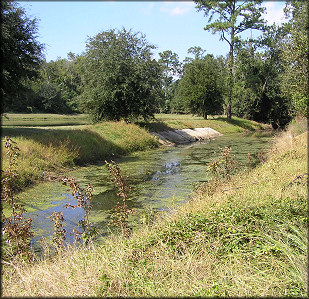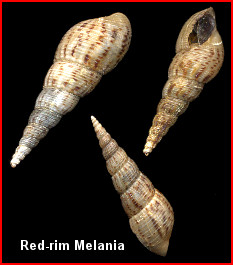|
Over the past year, using
satellite imagery, aerial photography, and topographic maps, the
senior author has been surveying the presence of the freshwater
Florida Apple Snail [Pomacea paludosa (Say, 1829)] in Duval
County. This study, focused on the south side of the county,
involves identifying likely snail population areas using the map and
photography aids and then conducting an on-site investigation.
Previously published material had indicated that “…the species is
not able to survive the lower winter temperatures that occur along
the northern tier of Florida counties and northward” – a conclusion
that was easily proven incorrect.
Most of the locations
visited during the study were either small lakes (borrow
pits/retention ponds) or simply drainage ditches running through
residential areas. For the most part, the latter are usually quite
shallow and during dry weather have a minimal amount of water.
However, following heavy rains, the run-off from the surrounding
developed areas can easily raise the water level up to six feet and
quickly turn an ankle deep ditch into a raging river. Because of
this sudden influx of water, many of the terrestrial mollusks, as
well as their empty shells, from the surrounding area are washed
into the ditch and ultimately end up in large conglomerations of
vegetation at the high water mark (also referred to by some as the
high water wrack line; see
Freshwater Shell Collecting In Alabama and the Nov.-Dec., 1996
Shell-O-Gram) along with the aquatic species that reside in the
ditch itself. One example of this is Bennett Branch on Bowden Road
in southern Jacksonville – the topic of this report. |
|
 Bennett Branch, a tributary of Pottsburg Creek (and thence the St.
Johns River), was first visited on 10/20/2005 and a live Pomacea
paludosa was immediately discovered immediately adjacent to
Bowden Road. This was somewhat amazing considering how small the
creek was and its obvious poor water quality. A later article in the
Florida Times-Union confirmed the water quality observation
with a report of a fecal coliform reading of 3,000 (a reading of
over 800 is considered a health risk). A large amount of high water
wrack was also present in the same area which was visually replete
with both terrestrial and aquatic species. The junior author was
told of the profuse wrack and asked whether he would like a gallon
of the material for microscopic examination. Upon his approval, a
return visit to Bennett Branch was made on 11/1/2005 and the sample
was obtained.
Bennett Branch, a tributary of Pottsburg Creek (and thence the St.
Johns River), was first visited on 10/20/2005 and a live Pomacea
paludosa was immediately discovered immediately adjacent to
Bowden Road. This was somewhat amazing considering how small the
creek was and its obvious poor water quality. A later article in the
Florida Times-Union confirmed the water quality observation
with a report of a fecal coliform reading of 3,000 (a reading of
over 800 is considered a health risk). A large amount of high water
wrack was also present in the same area which was visually replete
with both terrestrial and aquatic species. The junior author was
told of the profuse wrack and asked whether he would like a gallon
of the material for microscopic examination. Upon his approval, a
return visit to Bennett Branch was made on 11/1/2005 and the sample
was obtained.
The sample was
oven-dried, kneaded, and sifted. The process allowed culling of a
few dozen larger (over four mm) shells and produced a little over a
pint of coffee-ground-like material in two grades of minimal
dimension, 2-4 mm and less than 2 mm, in about equal volumes. These
sub-samples samples were searched using a grid under the stereo
microscope at 10 to 20X. Shells were culled, sorted, and identified
using the usual methods.
The results were rather
productive for a single station - 37 spp., and all but one from the
drift sample. The presence of a both land (26) and freshwater (11)
species contributed to the diversity:
Campeloma floridense (Call, 1886) Purple-throat Campeloma
[visual recon by Bill]
Fossaria cubensis (Pfeiffer, 1839) Carib Fossaria
Physella heterostropha (Say, 1817) Pewter Physa
Gyraulus parvus (Say, 1817) Ash Gyro
Menetus dilatatus avus (Pilsbry, 1905) Keeled Bugle
Sprite
Menetus floridensis (F. C. Baker, 1945) Penny Sprite
Planorbella trivolvis (Say, 1817) Marsh
Rams-horn
Hebetancylus excentricus (Morelet, 1851) Excentric Ancylid
Pisidium casertanum (Poli, 1791) Ubiquitous Peaclam
Sphaerium occidentale (J. Lewis, 1856) Herrington Peaclam
Melanoides tuberculata (Müller, 1774) Red-rim Melania
Gastrocopta pellucida (Pfeiffer, 1841) Slim Snaggletooth
Gastrocopta rupicola (Say, 1821) Tapered Snaggletooth
Gastrocopta servilis (Gould, 1843) Wandering Snag
Gastrocopta tappaniana (C.B. Adams, 1841) White Snaggletooth
Pupisoma dioscoricola (C.B. Adams, 1845) Yam Babybody
Pupisoma mcneilli (G. Clapp, 1918) Gulf Babybody
Pupoides modicus (Gould, 1848) Island Dagger
Vertigo milium (Gould, 1840) Blade Vertigo
Vertigo oralis Sterki, 1898 Palmetto Vertigo
Vertigo ovata Say, 1822 Ovate Vertigo
Succinea campestris Say, 1818 Crinkled Ambersnail ?
Succinea unicolor Tryon, 1866 Squatty Ambersnail
Oxyloma effusum (Pfeiffer, 1853) Coastal Plain
Ambersnail
Lucilla cf. singleyana (Pilsbry, 1889) cf. Smooth Coil
Hawaiia minuscula (A. Binney, 1841) Minute Gem
Ventridens cerinoideus (Anthony, 1865) Wax Dome
Ventridens demissus (A. Binney, 1843) Perforate Dome
Zonitoides arboreus (Say, 1817) Quick Gloss
Dryachloa dauca Thompson and Lee, 1981 Carrot Glass
Euconulus trochulus (Reinhart, 1883)
Silk Hive [lost in
processing]
Polygyra cereolus (Mühlfeld, 1816) Southern Flatcoil
Polygyra septemvolva Say, 1818 Florida Flatcoil
Allopeas gracile (Hutton, 1834) Graceful Awlsnail
Opeas pyrgula Schmacker and Böttger, 1891 Sharp Awlsnail
Huttonella bicolor (Hutton, 1834) Two-tone Gullela
Bradybaena similaris (Férussac, 1821) Asian Trampsnail
The composition of this fauna warrants some comment. There
are two species new to the cumulative NE Florida checklists
(freshwater and terrestrial respectively) in blue. Each is certainly
know to prosper in “stressed habitats” (roadside ditches and cleared
grassland respectively) as are the vast majority of the other listed
species. One of the aquatic species, the Red-rim Melania (see image), and six of
the landsnails, the Wandering Snag, Perforate Dome, Graceful
Awlsnail, Sharp Awlsnail, Two-tone Gullela, and Asian Trampsnail are
non-indigenous species and almost expected to occur in such a
setting. On the other the Yam Babybody, Gulf Babybody, and Palmetto
Vertigo (see image) are more characteristic of swamp of low woods habitats and
their shells were more likely transported into the wrack from
relatively remote upstream origins. It is for that reason that
“drift shells” are not accorded full status by zoogeographers and
ecologists. For our purposes, however, the opportunity to obtain a
greater sample of species diversity is of certain value. We can now
count 78 terrestrial and 60 aquatic molluscan taxa in the northeast
Florida fauna. |



 Bennett Branch, a tributary of Pottsburg Creek (and thence the St.
Johns River), was first visited on 10/20/2005 and a live Pomacea
paludosa was immediately discovered immediately adjacent to
Bowden Road. This was somewhat amazing considering how small the
creek was and its obvious poor water quality. A later article in the
Florida Times-Union confirmed the water quality observation
with a report of a fecal coliform reading of 3,000 (a reading of
over 800 is considered a health risk). A large amount of high water
wrack was also present in the same area which was visually replete
with both terrestrial and aquatic species. The junior author was
told of the profuse wrack and asked whether he would like a gallon
of the material for microscopic examination. Upon his approval, a
return visit to Bennett Branch was made on 11/1/2005 and the sample
was obtained.
Bennett Branch, a tributary of Pottsburg Creek (and thence the St.
Johns River), was first visited on 10/20/2005 and a live Pomacea
paludosa was immediately discovered immediately adjacent to
Bowden Road. This was somewhat amazing considering how small the
creek was and its obvious poor water quality. A later article in the
Florida Times-Union confirmed the water quality observation
with a report of a fecal coliform reading of 3,000 (a reading of
over 800 is considered a health risk). A large amount of high water
wrack was also present in the same area which was visually replete
with both terrestrial and aquatic species. The junior author was
told of the profuse wrack and asked whether he would like a gallon
of the material for microscopic examination. Upon his approval, a
return visit to Bennett Branch was made on 11/1/2005 and the sample
was obtained.